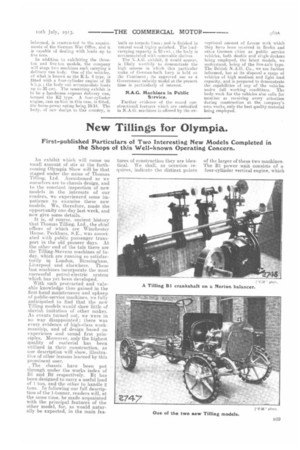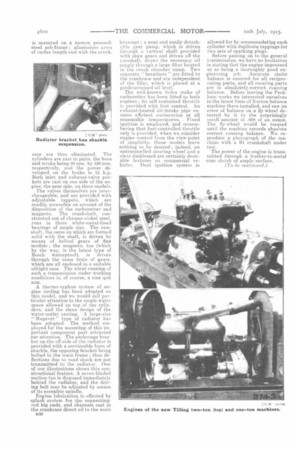New Tillings for Olympia.
Page 21

Page 22

If you've noticed an error in this article please click here to report it so we can fix it.
First-published Particulars of Two Interesting New Models Completed in the Shops of this Well-known Operating Concern.
An exhibit which will rouse no small amount of stir at the forthcoming Olympia Show will be that staged under the name of Thomas Tilling, Ltd. Accustomed as we ourselves are to chassis design, and to the constant inspection of new models in the intereas of our readers, we experienced some impatience to examine these new models. We, therefore, made the opportunity one day last week, and now give some details.
it is, of course, ancient history that Thomas Tilling, Ltd., the chief offices of which are Winchester House, Peckham, S.E., was associated with public passenger transport in the old pioneer days. At the other end of the tale there are the Tilling-Stevens machines of today. which are running so satisfactorily in London, Birmingham, Liverpool and elsewhere. These last machines incorporate the most s uesie as NI pet rol-electric system which has yet been developed.
With such protracted and valuable knowledge thus gained in the first-hand maintenance and upkeep of public-service machines, we fully anticipated to find that the new Tilling models would show little of slavish imitation of other makes. As events turned out, we were in no way disappointed ; there was every evidence of high-class workmanship, and of design based 011 experience and sound first principles. Moreover, only the highest quality of material has been utilized in their construction, as our description will show, illustrative of other lessons learned by this prominent user.
, The chassis have been put through under the. works index or 131 and B2 respectively. B1 has been designed to carry a useful load of 1 ton, and the other to handle 2 tons. In following our full description of the 1-tonner, readers will, at the same time, be made acquainted with the principal features of the other model, for, as would naturally be expected, in the main fea
tures of construction they are identical. We shall, as occasion requires, indicate the distinct points
of the larger of these two machines. The B1 power unit consists of a four-cylinder vertical engine, which is mounted on a narrow pressedsteel sub-frame ; aluminium arms of undue length cast with the crank_
ease are thus eliminated. The cylinders are cast in pairs, the bore and stroke being 80 rrinn by 120 mm. respectively, and the power developed on the brake is 15 h.p. Both inlet and exhaust-valve pockets are cast on one side of the engine, the near side, on these models. The valves themselves are interchangeable, and are provided with adjustable tappets, which are readily accessible on account of the disposition of the carburetter and magneto. The crankshaft, constructed out of chrome-nickel steel, runs in three white-metal-lined bearings of ample size. The camshaft, the cams on which are formed solid with the shaft, is driven by means of helical gears of fine module ; the magneto, too (which by the way, is the latest type of Bosch waterproof), is driven through the same train of gears, which are all enclosed in a suitable oiltight case. The silent running of such a transmission under working conditions is, of course, a sine qua non.
A thermo-syphon system of engine cooling has been adopted on this model, and we would call particular attention to the ample water space allowed on top of the cylin dens, and the clean design of the water-outlet casting. A large-size " Megevet " type of radiator has been adopted. The method employed for the mounting of this important component part attracted our attention. The anchorage bracket on the off-side of the radiator is provided with a serviceable form of shackle, the opposing bracket being bolted to the main frame ; thus deflections due to road shock are not transmitted to the radiator. One of our illustrations shows this constructional feature. A seven-bladed suction fan is disposed immediately behind the radiator, and the driving belt may be adjusted by means of its eccentric spindle.
Engine lubrication is effected by splasa system for the connectingrod big ends, and channels east in the crankcase direct oil to the main D30 bearings ; a neat and easily-detachable gear pump, which is driven through it vertical shaft provided with skew gears and driven off the camshaft, draws the necessary oil supply through a large filter located in the crank chamber sump. Two separate " breathers" are fitted to the crankcase and are independent of the filler, which is placed at a predetermined oil level.
The well-known Solex make of carburetter has been fitted to both engines ; its self contained throttle is provided with foot control. An exhaust-heated air-intake pipe ensures efficient carburation at all reasonable temperatures. Fixed ignition is employed, and remembering that foot-controlled throttle only is provided, when we consider engine control from the view-point of simplicity, these models leave nothing to be desired ; indeed, an untrammelled steering wheel and a clear dashboard are certainly desirable features on commercial vehicles. Dual ignition system is allowed for by accommodating each cylinder with duplicate tappings for two sets of sparking plugs.
Before passing on to the general tYansinission, we have no hesitation in stating that the engine impressed us as being a thoroughly good engineering job. Accurate static balance is ensured for all reciprocating parts, and all rotating parts are in absolutely-correct running balance. Before leaving the Peckham works we interested ourselves in the latest form of Norton balance machine there installed, and saw an error oe balance on a fly-wheel detected by it to the surprisingly small amount of .068 of an ounce. The fly-wheel would be treated until the machine records absolute correct running balance. We reproduce a photograph of the machine with a B1 crankshaft under test.
The power of the engine is transmitted through a leather-to-metal cone clutch of ample surface.
(To be continued.)
































